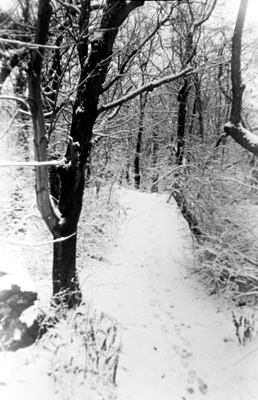All Nonfiction
- Bullying
- Books
- Academic
- Author Interviews
- Celebrity interviews
- College Articles
- College Essays
- Educator of the Year
- Heroes
- Interviews
- Memoir
- Personal Experience
- Sports
- Travel & Culture
All Opinions
- Bullying
- Current Events / Politics
- Discrimination
- Drugs / Alcohol / Smoking
- Entertainment / Celebrities
- Environment
- Love / Relationships
- Movies / Music / TV
- Pop Culture / Trends
- School / College
- Social Issues / Civics
- Spirituality / Religion
- Sports / Hobbies
All Hot Topics
- Bullying
- Community Service
- Environment
- Health
- Letters to the Editor
- Pride & Prejudice
- What Matters
- Back
Summer Guide
- Program Links
- Program Reviews
- Back
College Guide
- College Links
- College Reviews
- College Essays
- College Articles
- Back
Stopping by Death on a Cold Journey
Stopping by Death on a Cold Journey
Robert Frost’s poem “Stopping by Woods on a Snowy Evening” has survived through the ages because of his knowledge of words’ sound and tone, metaphorical language, imagery, and indispensable poetry tools. Comparing common matter – a forest, a horse, a village, and a man - to deep theological items – death, peers, Heaven, and human kind – Frost penned a poem that would last for centuries to come, as it encompasses how humans think and are tempted and the triumph over both.
Using five major entities, Frost artfully pens his outlook on life through the metaphor of a man returning to his house from a day’s labor. The players are as follows: the man’s journey, the woods, the farmhouse below, the horse, and the man himself. The man represents all people who feel overwhelmed and ponder the “woods” as an alternative to continuing their trail home. The man’s trek with his horse represents every human’s walk through life. Overwhelmed by life’s burdens, he stops a moment to ponder an alternative to his road.
His alternative is the wood. The woods, central to the telling of the poem, represent death. The man physically stops his journey to look at the woods, but metaphorically considers exchanging life’s cold passage for death. Appearing as beautiful, yet dark, enticing, yet threatening, death looms before the man on his way home. Frost captures the terrifying beauty of a lonely, dark wood, and draws the parallel between the forest and man’s demise.
Although it is warm and inviting, Heaven, represented by the below village and the man’s home, seems distant and difficult to attain, while the woods (direct death) appear as a simple alternative. His horse “must think it queer” for the man to stop and consider the woods as he does and corresponds to his human counterparts who would think it equally odd for Frost to reflect on death.
Emphasizing the sleep of death, Frost repeats the of the poem’s last two lines, “And miles to go before I sleep,” stressing the remainder of the man’s life. Frost has years to live before death accepts him and assures the reader that he will not venture into the woods. Correspondingly, the man has miles to travel before he arrives home and we humans have years to live before permanent rest.
Beyond metaphorical language and repetition, Frost employs imagery to convey his message to his audience. Emphasizing the cold of the woods, Frost refers to “snow” and a “frozen lake,” reminding the reader that the man’s walk and our voyage through life is bitter and hard. In contrast, the sounds associated with the woods are soothing, enticing the reader and man to enter. The snowflakes and wind appear restful and sweet, as opposed to the cold of the darkest night of the year. Crooning, “The woods are lovely, dark and deep,” Frost portrays the woods as strangely welcoming and open, yet also cold and dangerous.
Setting the poem during the “darkest evening of the year,” Frost sets the tone as shadowy and cold, but with its “lovely, dark, and deep” woods, relaxes the minds of his readers. Describing the forest with soft words such as “lovely” and “downy,” Frost shapes the woods (death) as an appealing, mysterious alternative to the grind of daily life, soothing the reader into a lull of mind. While describing the sounds surrounding him on the edge of the woods, Frost pens of “easy wind and downy flake,” further setting the reader’s mind at rest.
Frost’s understanding of poetry’s mechanics completes the poem. Iambic rhythm, the natural flow of the English language, is an unaccented syllable followed by an unaccented one; Frost employed this pattern in “Stopping by Woods.” By using such an instinctive pattern, Frost broadens the calming effect of his work. Extending the natural flow, Frost used an AABABBCB rhyming pattern. Instead of AABB or ABAB, the pattern he chose returns to the former stanza with the last words in the first two lines, tying the work together in uniformity.
Robert Frost’s poem “Stopping by Woods on a Snowy Evening” tells of his thoughts on death, his realizing its temptations, and his overcoming them. He does not pass by the enticing wood because of fear or other people’s opinion, but because “he has promises to keep.” We as humans can but guess what those promises were – promises made to his family or friends, or maybe the simple responsibility of living that is placed on all our shoulders. Whatever those “promises” were, the conveyance of his pausing by death is memorable through the telling; Frost disguised his true thoughts behind the veil of woods and a horse, instead of death and his peers. Reflecting the woods in his poem, Frost’s writing is “lovely, dark and deep,” as he stops by woods on a snowy evening.

Similar Articles
JOIN THE DISCUSSION
This article has 0 comments.
